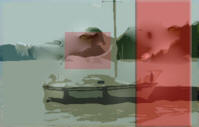 |
 |
| www.BananaWind.us |
A vessel is deteriorating from the moment it is built. - Willits D. Ansel |
 |
 |
| www.BananaWind.us |
A vessel is deteriorating from the moment it is built. - Willits D. Ansel |
|
If you have an aversion to labor and don't like fixing things, you have no business owning a boat. |
Yanmar 1GM Cutaway Photographs
|
1. |
Cleaning
Tips
|
|
| 2. |
Freeing
Frozen Shackle Pins
Tap with a hammer around the hole where the pin screws in OR soak around the threads with penetrating oil OR heat the shackle with a torch until it is red hot |
|
| 3. |
Preventing
Shackle Pins from Freezing Up
Before screwing the pin home, coat the threads with grease OR Vaseline OR lanolin OR pine tar |
|
| 4. |
Homemade Multipurpose
Grease for General Maintenance
3 pounds (or 3 parts) tallow 1 pound (or 1 part) soft soap 1 pound (or 1 part) Vaseline Heat all together, stir thoroughly, turn off heat, and continue stirring until the mixture begins to set up. |
|
| 5. |
Modern Marine Sealants
|
|
| 6. |
Cleaning Up Uncured
Marine Sealants
Polyurethane--rubbing alcohol Polysulfide--mineral spirits Silicone--acetone Flexible epoxy--acetone or lacquer thinner Conventional putty and bedding compounds--mineral spirits |
|
| 7. |
Painting and Varnishing
The finest, most expensive paint or varnish, applied with the finest, most expensive brush in the western world will not last if the underlying surface is not ready for it.
|
|
| 8. |
Light-reflecting Power of
Paint Colors
|
|
| 9. |
Four Principle Elements
of a Good Varnish Job
1. Good weather on varnishing day. 2. Good, clean, well-broken-in brushes designed for varnishing. 3. Good varnish application technique--flow it on; not too much varnish, not to little; don't overbrush. 4. Even buildup of coats--no fewer than five--with light sanding between coats. |
|
| 10. |
Conditions for Painting
and Varnishing
50 to 80 degrees F for painting. 60 to 80 degree F for varnishing. Calm and clear. Do not paint or varnish when the weather is damp or foggy. Avoid varnishing under direct sunlight on hot days. Surfaces should be free of moisture, dust, oil, grease, and rust. Allow sufficient time for the surface to at least skin over before sunset. |
|
| 11. |
Bottom Paint Coverage
Boat Length X Boat Width X .085 = Square Footage Compare the required need based on the calculated square footage to the available coverage estimated by the paint manufacturer on the paint can and purchase the appropriate amount. |
![]()
The Last Priest available at TheLastPriest.com